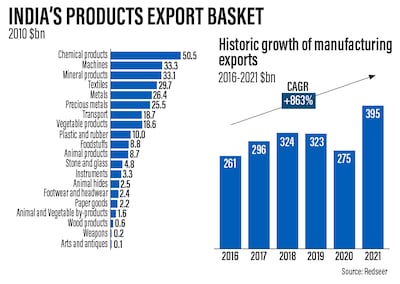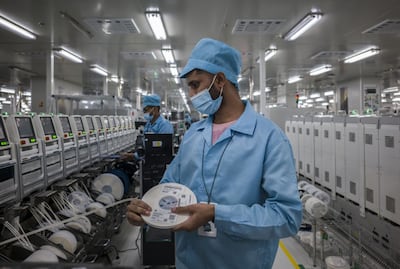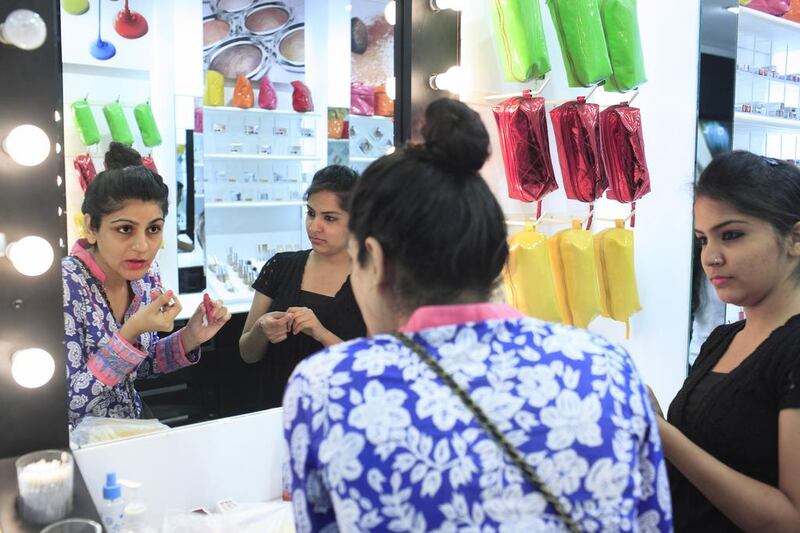A “revolution” is taking place in India's manufacturing sector: companies are looking to cut dependence on China for parts and materials amid Covid-19 lockdowns and geopolitical tensions, giving wings to Indian ambitions of becoming a global production hub, analysts say.
“I think geopolitics has done India a favour by opening everyone's eyes to the fact that you have to diversify [geographically],” says Barnik Maitra, managing partner at international consultancy Arthur D Little, India. “Indian manufacturing is stepping up. It's stepped up on quality. It's stepped up on delivery. What's happened in the past 18 months has been nothing short of unbelievable.”
As companies ramp up manufacturing in India, across categories ranging from cars to electronics, several manufacturers are also increasingly moving towards greater innovation and making more components locally, compared to largely focusing on assembling products using imported parts in the past, he says.
“There is a quiet revolution happening,” says Mr Maitra.
India's prime minister Narendra Modi soon after coming to power in 2014 launched his flagship “Make in India” campaign, which aims to transform the country into a global manufacturing hub. It targets manufacturing growth to account for 25 per cent of the economy by 2025, up from 15 per cent in 2014.
This plan is widely considered highly ambitious. Manufacturing currently accounts for about 17 per cent of India's gross domestic product, according to Redseer Strategy Consultants.
While progress for several years was slow, experts say that the country's manufacturing industry is gathering momentum. India's goods exports hit a record high of more than $400 billion in the financial year to the end of March, official data shows.
“I truly believe that foreign companies are increasingly turning to India to build their manufacturing units,” says Mukul Goyal, co-founder of Stratefix Consulting. “Post the pandemic, companies have realised that depending on a single location for manufacturing is not beneficial for them. India, therefore, comes as a relief to those looking for an additional location.”
He adds that “China has established itself as a monopoly in the manufacturing market, but over the last few years, there has been a change of perspective”. But India is still an “upcoming manufacturing destination” with a lot of catching up to do.
Mr Goyal says that factors including a large, young workforce and English being widely spoken in the country are features which make India an attractive destination for manufacturing, along with the digitisation that is rapidly taking place in the country.
However, there are still several hurdles that India's manufacturing industry faces, he adds.

These include challenges surrounding policy implementation, an unwillingness on the part of factory owners to invest in the latest technology, and a dearth of affordable finance.
Nonetheless, in a recent report, Redseer concluded that “definitely, India holds the potential to become the next manufacturing hub in the world”.
It highlighted that “factors like favourable government policies, low-wage labour, and quality talent will fuel India’s manufacturing sector. The wages of Indian workers have come out as one of the best in terms of value compared to their counterparts in other relevant countries”.
India is also gradually transitioning to more automated and process-driven manufacturing, it said.
“Stability in terms of government policies, real estate availability, global supply chain linkages, labour costs” are all positives, says Kalyan C Korimerla, managing director and co-promoter at Etrio Automobiles, an automotive manufacturing company.
“While almost no country offers the perfect matrix in this regard, over the last few years in India, things have improved a lot.”
Ambud Sharma, director at Indian fashion house Escaro Royale, says, “the main advantage is the cost factor. In China, labour costs are extremely high, and they're getting more expensive by the year”.

In a further boost for India, US treasury secretary Janet Yellen on Friday during a visit to New Delhi pushed for closer India and US ties to diversify away from China. Speaking at an event, Ms Yellen said that it was important to “diversify away from countries that present geopolitical and security risks to our supply chain” and boost economic relations with “trusted partners like India”.
She described Apple's decision to shift some of its production from China to India as progress.
Apple is one of the most high-profile companies that has been diversifying away from a heavy dependence on China for its manufacturing, as Covid-related lockdowns have disrupted work, and as tensions simmer between Washington and Beijing.
The US tech giant is manufacturing its new flagship iPhone 14 in India, as part of this strategy. The company has been manufacturing in India since 2017.
Bloomberg reports that iPhone exports from India reached more than $1bn in the five months since April, and that shipments of the devices — mainly to the Middle East and Europe — are set to almost double to reach $2.5bn by the end of March 2023 compared to the previous year.
India's large and growing consumer market is another factor that makes the country an attractive market to make goods.
“Everyone has realised that it is easier to crack India as a market if you have other interests in India as well,” says Mr Maitra. “It is no coincidence that Apple is investing so much money in India — because it is one of the markets where it has the lowest penetration of its products.”
Many domestic companies are also becoming more focused on local manufacturing opportunities.
Gizmore, an Indian smart accessories and audio brand, which launched in 2018, mainly relied on imports when it started out. But it has moved towards manufacturing in India, partnering with local vendors, and all of its smartwatches are now made in the country, along with most of its audio equipment.
“We have handheld some of these vendors to scale their Indian operations and shared our learnings of working with the Chinese counterparts,” says Sanjay Kumar Kalirona, chief executive and co-founder of Gizmore.
Its target is to manufacture all its products in India by the end of the next financial year.
“We have constantly been scaling our manufacturing operations in the country,” says Mr Kalirona. “A small fraction of the products are still made in other countries, including China.”
He says that the government's Make in India initiative and the introduction of production-linked incentives “have played a vital role in the growth of home-grown brands in India”.
There are still a lot of components, however, that are not made in India, which means that the country has a long way to go.
“Most of the components, especially for TVs, still need to be manufactured in China and thus have to be imported,” says Saket Gaurav, chairman and managing director of Indian consumer electronics brand Elista and its parent company TeknoDome.
For some, finding the right talent is also proving to be an issue.
“While labour is available, training them with the right skills and retention is a challenge in the manufacturing work force,” says Pankaj Sharma, co-founder at Log9 Materials, an Indian nanotechnology company, based in Bangalore, which produces battery packs and is rapidly expanding its manufacturing operations.
“Government regulatory hurdles sometimes slow down new manufacturing setups in India ... and stable power and waste disposal mechanism needs to be further strengthened.”
But overall, he says that the environment is improving for manufacturers, with support and incentives from the state government and favourable policies from the central government.
Mr Maitra at Arthur D Little says that the limited availability of basic raw material also cannot be ignored when it comes to India scaling up its manufacturing sector.
“It's not easy,” he says. “This is not a country with a manufacturing legacy.”
There is a lot working in India's favour, says Sonal Jindal, founder of Medusa Exim, a supply chain management company.
But there is stiff competition.
“India could learn from countries like Bangladesh, Vietnam and, of course, China, whose labour-intensive exports are leading their growth since these sectors are not caught up in the rigmarole of regulations as well as restriction,” says Ms Jindal.
“The manufacturing sector in India seems to be in a paradoxical position right now. The future looks bright, but the present needs a lot of improvement.”














